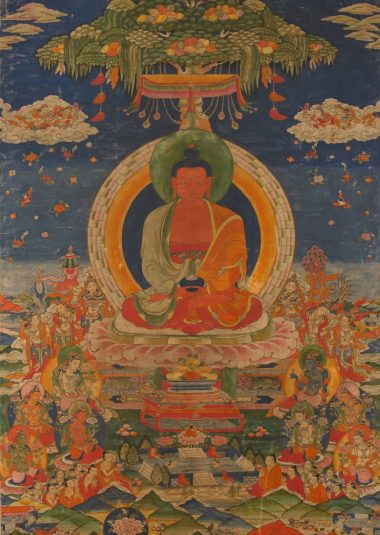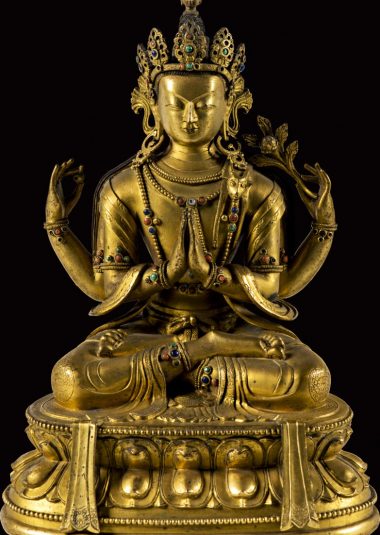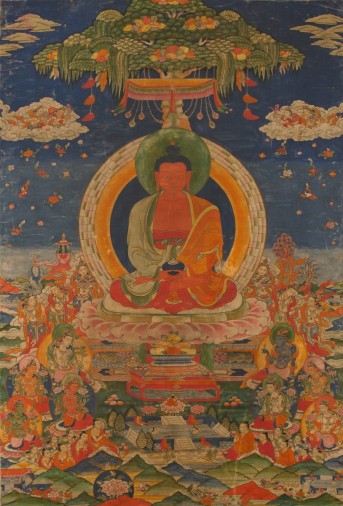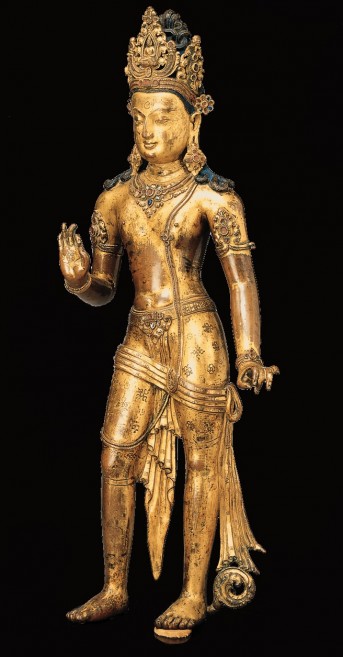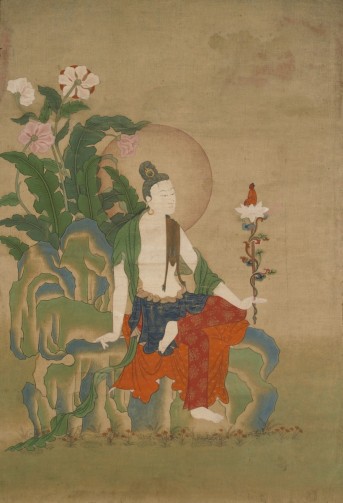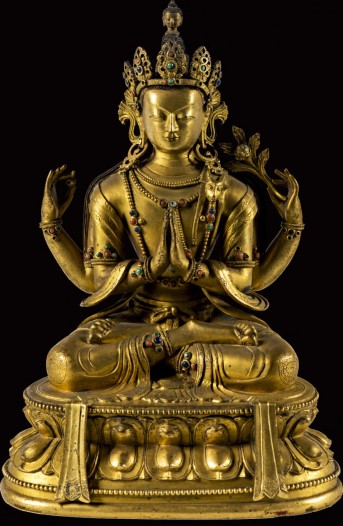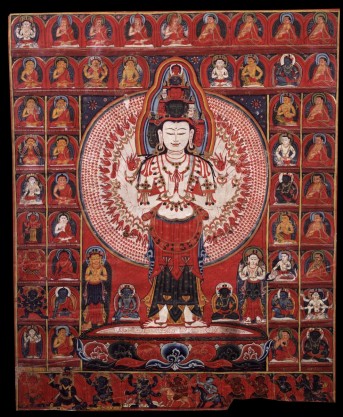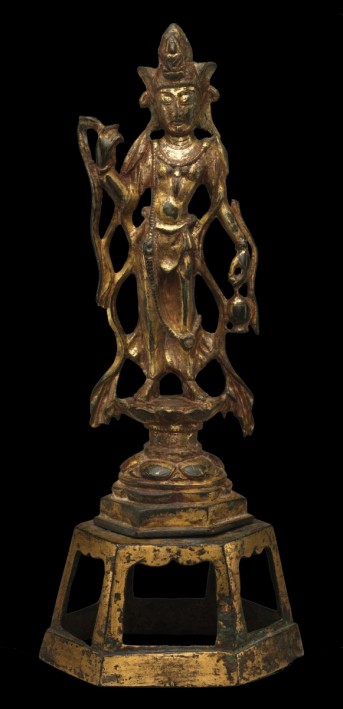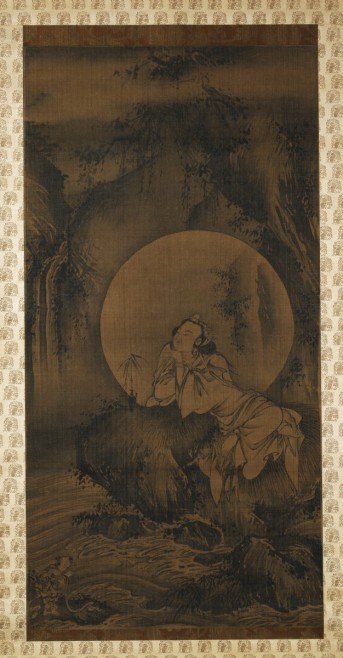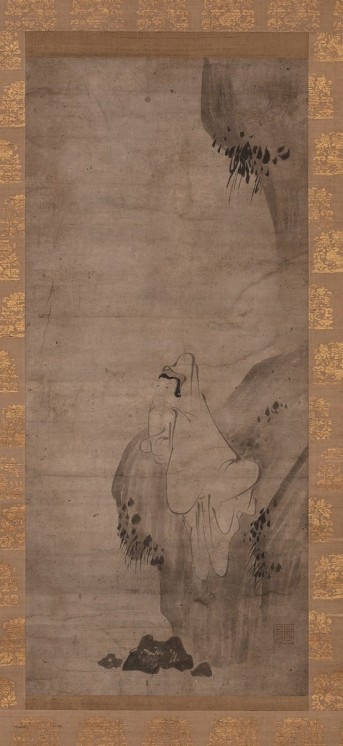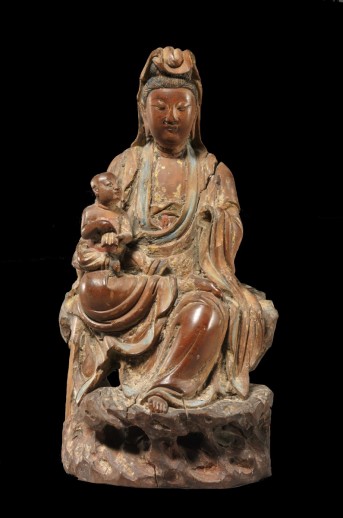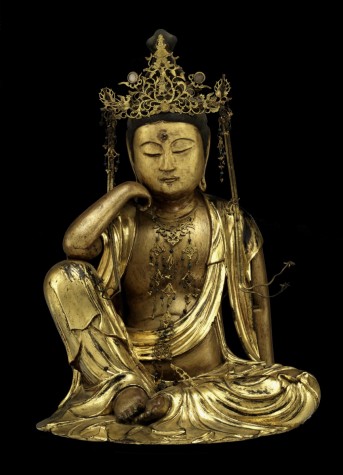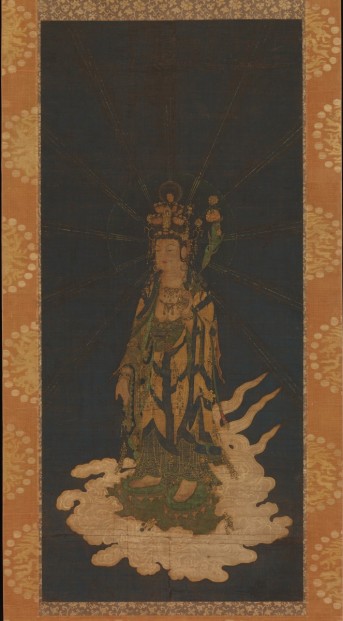Image
The objects in this section demonstrate the many ways that artists have represented Avalokiteshvara throughout the centuries. The bodhisattva’s iconography initially emerged in India almost two thousand years ago. At first he played a subsidiary role as attendant to the buddhas Shakyamuni or Amitabha and then became an independent focus of veneration. In East Asia, Avalokiteshvara took on feminine, maternal forms. The bodhisattva’s graceful sitting and standing postures, gestures, attributes, and idealized body are fundamentally iconic and symbolic. Each visual aspect points to an essential Buddhist ideal, especially the inseparability of compassion and wisdom. An outstretched hand or an upraised teaching gesture expresses these values; his white color and lotus convey purity, while the willow symbolizes healing abilities. Multiple heads and limbs indicate esoteric forms, signifying increased power. Avalokiteshvara’s most identifiable attribute is a small buddha on his crown, an icon of his spiritual father Amitabha.
1. Amitabha Buddha
Central Tibet, 19th century; pigment on cloth; 38 1/2 x 25 1/2 in.; The Rubin Museum of Art, New York, F1997.6.3.
2. Bodhisattva Avalokiteshvara in the Form of Khasarpana Lokeshvara
India, Bihar or Bengal, Pala period, late 11th–early 12th century; schist; 37 1/2 x 18 1/2 x 6 3/4 in.; Asia Society, New York, Mr. and Mrs. John D. Rockefeller 3rd Collection, 1979.40, photo: Lynton Gardiner, Courtesy of Asia Society, New York.
3. The Bodhisattva Avalokiteshvara
Nepal, Transitional period, late 10th–early 11th century; gilt copper alloy with inlays of semiprecious stones; 26 3/4 x 11 1/2 x 5 1/4 in.; Asia Society, New York, Mr. and Mrs. John D. Rockefeller 3rd Collection, 1979.47, photo: Susumu Wakisaka, Idemitsu Museum of Arts, Tokyo, Courtesy of Asia Society, New York.
4. Avalokiteshvara, One of the Eight Great Bodhisattvas
Eastern Tibet, 18th century; pigment on cloth with silk mount; 39 3/8 x 20 3/4 x 1/2 in.; The Rubin Museum of Art, New York, C2008.9.
5. Four-Armed Avalokiteshvara
China or Tibet, 18th–19th century; gilded metal with inlays; 10 1/4 x 7 1/4 in.; Jacques Marchais Museum of Tibetan Art, 85.04.0682.
6. The All-seeing Lord Avalokiteshvara
Tibet, 14th–15th century; ground mineral pigment on cotton; 29 1⁄4 x 25 1⁄4 x 1 1⁄4 in.; The Rubin Museum of Art, New York, C2006.66.190.
7. Bodhisattva Avalokiteshvara (Guanyin)
China, Tang dynasty, late 7th–8th century; gilt leaded bronze, piece-mold cast; H. 9 1/6 in.; The Metropolitan Museum of Art, Fletcher Fund, 1933, 33.91, photo: www.metmuseum.org.
8. White-robed Guanyin
Inscribed by Quanshi Zongle (1318–1391), China, Ming dynasty, late 14th century; hanging scroll, ink on paper; image: 36 x 12 7/8 in., mount: 70 x 17 5/8 in., The Metropolitan Museum of Art, Edward Elliott Family Collection, The Dillon Fund Gift, 1982, 1982.3.3, photo: www.metmuseum.org.
9. White-robed Kannon (Pandaravasini Avalokiteshvara)
Japan, Muromachi period, late 14th century; hanging scroll, ink on silk; image: 37 15/16 x 19 3/8 in., mount: 73 1/4 x 23 15/16 in.; Princeton University Art Museum, Gift of Duane Wilder, Class of 1951, y1992-6, photo: Bruce M. White, Courtesy of Princeton University Art Museum/Art Resource, NY.
10. White-robed Kannon
Attributed to Shugen (fl. 1469–1521), Japan, Muromachi period; hanging scroll, ink on paper; 32 ¼ x 14 5/16 in.; The Frances Lehman Loeb Art Center, Vassar College, Purchase, gift of Mr. and Mrs. Leo Steinberg (Dorothy Seiberling, class of 1943); Elizabeth Woodcock, class of 1925; Bertha Mather McPherson, class of 1928 and Philip Johnson, by exchange, 2014.29.
11. Songzi Guanyin, Bodhisattva Avalokiteshvara as the Bestower of Children
China, late Ming or Qing dynasty, 17th–18th century; sandalwood with traces of pigment and gilding, single-woodblock construction; 5 3/8 x 2 3/4 x 2 1/2 in.; The Metropolitan Museum of Art, Rogers Fund, 1951, 51.15, photo: www.metmuseum.org.
12. Nyoirin Kannon
Japan, Edo period, ca. 1693; wood with gold, gold leaf, lacquer, and crystal inlay; 16 9/16 x 12 1/8 x 10 1/4 in.; The Metropolitan Museum of Art, Rogers Fund 1956, 56.39, photo © The Metropolitan Museum of Art; source: Art Resource, NY.
13. Descent of Eleven-headed Kannon (Avalokiteshvara)
Japan, Kamakura period, 14th century; hanging scroll, ink, color, gold, and cut gold on silk; image: 33 15/16 x 15 1/4 in., mount: 64 1/4 x 19 1/2 in., The Metropolitan Museum of Art, Purchase, Charles Wrightsman Gift, Joseph Pulitzer Bequest, Dodge, Pfeiffer and Rogers Funds, and funds from various donors, 1972, 1972.181, photo: www.metmuseum.org.




